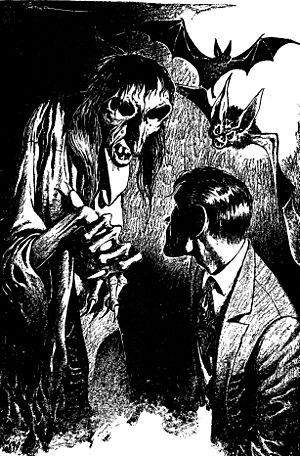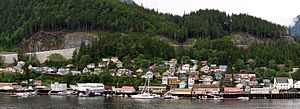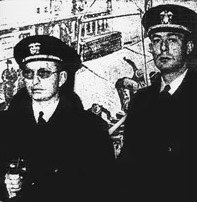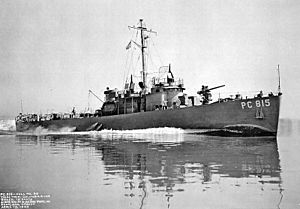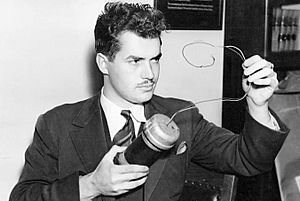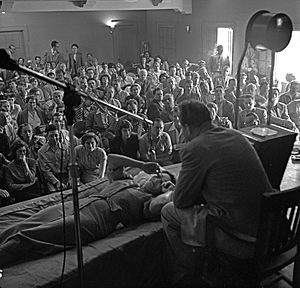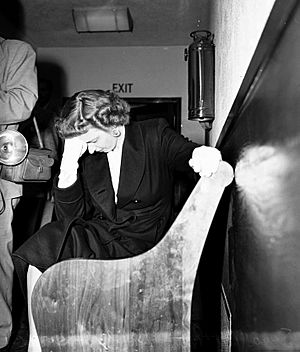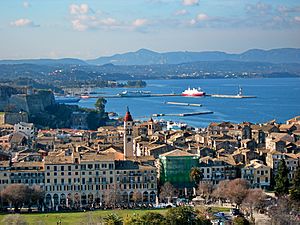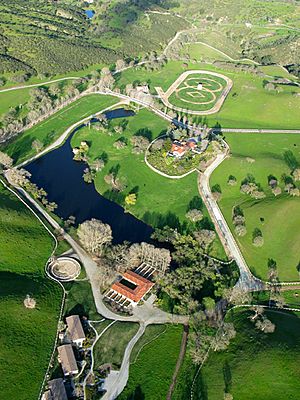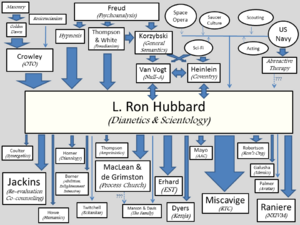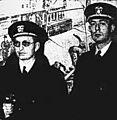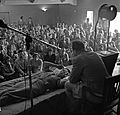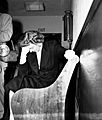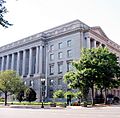L. Ron Hubbard facts for kids
Quick facts for kids
L. Ron Hubbard
|
|
|---|---|
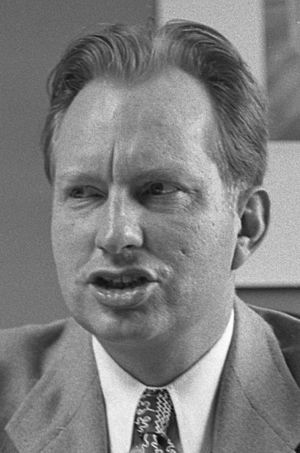
Hubbard in 1950
|
|
| Born |
Lafayette Ronald Hubbard
March 13, 1911 Tilden, Nebraska, U.S.
|
| Died | January 24, 1986 (aged 74) Creston, California, U.S.
|
| Education | George Washington University (dropped out) |
| Occupation | Author, religious leader |
| Known for | Inventor of Scientology |
|
Notable work
|
Dianetics: The Modern Science of Mental Health Battlefield Earth |
| Spouse(s) |
Margaret "Polly" Grubb
(m. 1933; div. 1947)Mary Sue Whipp
(m. 1952) |
| Children | 7:
With Margaret Grubb:
With Sara Hollister:
With Mary Sue Whipp:
|
| Relatives | Jamie DeWolf (great-grandson) |
| Military career | |
| Allegiance | |
| Service/ |
|
| Years of service | 1941–1945 (Active) 1945–1950 (Reserve) |
| Rank | |
| Commands held | USS YP-422 and USS PC-815 |
| Battles/wars | World War II |
| Awards |
|
| Signature | |
Lafayette Ronald Hubbard (March 13, 1911 – January 24, 1986) was an American author. He wrote many science fiction and fantasy stories. He is most famous for starting the Church of Scientology. In 1950, Hubbard wrote a book called Dianetics: The Modern Science of Mental Health. He then created groups to share his ideas about Dianetics.
Later, in 1952, Hubbard started Scientology. He helped the Church of Scientology grow into a worldwide organization.
Hubbard was born in Tilden, Nebraska, in 1911. He spent much of his childhood in Helena, Montana. In the late 1920s, he traveled to Asia and the South Pacific. This was after his father was sent to a U.S. naval base on Guam. In 1930, Hubbard started studying civil engineering at George Washington University. However, he left during his second year. He began his career writing many stories for magazines. He married Margaret "Polly" Grubb, who also liked aviation.
Hubbard served as an officer in the Navy during World War II. He briefly led two ships but was removed from command both times. He spent the last few months of his active service in a hospital for various health issues.
In 1953, the first Scientology churches were founded by L. Ron Hubbard. In 1954, a Scientology church in Los Angeles was started. This church later became the Church of Scientology International. Hubbard also added ideas about how to manage organizations, teach, communicate, and live a healthy life to Scientology's teachings.
During the 1960s, Scientology became more well-known. Hubbard spent a lot of time at sea in the late 1960s and early 1970s. He was on his own ships as "Commodore" of the Sea Organization. This was a special group of Scientologists.
Hubbard returned to the United States in 1975. He then lived away from public view in the California desert. He passed away at age 74 in January 1986. After his death, Scientology leaders said that he had chosen to "drop his body." They believed he would continue his work on another level of existence. The Church of Scientology describes Hubbard's life in very positive ways.
Contents
Hubbard's Early Life and Education
L. Ron Hubbard was born in 1911 in Tilden, Nebraska. He was the only child of Ledora May and Harry Ross Hubbard. His mother was a trained teacher. His father was a former United States Navy officer. After moving to Kalispell, Montana, they settled in Helena in 1913. Hubbard's father rejoined the Navy in April 1917 during World War I. His mother worked for the state government.
During the 1920s, the Hubbards moved many times across the United States and overseas. Hubbard was active in the Boy Scouts in Washington, D.C. He became an Eagle Scout in 1924. This was just two weeks after his 13th birthday.
In 1925, Hubbard started high school in Bremerton. The next year, he studied at Queen Anne High School in Seattle.
In April 1927, Hubbard's father was sent to Guam. That summer, Hubbard and his mother traveled to Guam. They stopped briefly in some Chinese ports. He wrote about his feelings on the places he visited. He noted the poverty in Japan and China.
In September 1927, Hubbard lived with his grandparents. He enrolled at Helena High School. He wrote for the school newspaper. On May 11, 1928, Hubbard left Helena High because of low grades. He then went back to Guam to join his parents in June 1928.
Between October and December 1928, Hubbard's family traveled from Guam to China. When he returned to Guam, Hubbard spent a lot of time writing short stories and essays. Hubbard tried to pass the entrance exam for the United States Naval Academy but did not succeed.
In September 1929, Hubbard enrolled at the Swavely Preparatory School. This was in Manassas, Virginia. He hoped to prepare for a second try at the Naval Academy exam. During his first semester, he complained of eye strain. He was diagnosed with myopia (nearsightedness). This meant he could not join the Naval Academy. As an adult, Hubbard would write to himself that his eyes got worse when he used them as an excuse to avoid the Naval Academy.
He was then sent to Woodward School for Boys in Washington, D.C. He needed to qualify for George Washington University without taking an entrance exam. He graduated from the school in June 1930. He started at the University that September.
University Life and Caribbean Trip
On September 24, 1930, Hubbard began studying civil engineering. This was at George Washington University. His father wanted him to study this. Hubbard did not do well in his studies. His school records show he failed many courses, including atomic physics. Later in life, he would claim to have been a nuclear physicist. In September 1931, he was put on academic probation due to poor grades. In April 1932, he received another warning for his lack of academic success. During his first year, Hubbard helped start the university Glider Club. He was elected its president.
During his last semester at GWU, Hubbard planned a trip to the Caribbean. This was for June 1932. He wanted to explore and film pirate hideouts. He also wanted to collect items for museums. The trip faced many problems. They ran low on money. The ship's owners ordered it to return to Baltimore. Hubbard did not go back to the University the next year.
His father asked him to volunteer for a Red Cross relief effort. On October 23, 1932, Hubbard traveled to Puerto Rico. On the way, Hubbard decided to leave the Red Cross. Instead, he went with a mineral surveyor. They tried to find gold, but it was not successful.
First Marriage and Early Writing Career
Hubbard returned from Puerto Rico to Washington, D.C., in February 1933. He started a relationship with Margaret "Polly" Grubb, a fellow glider pilot. They married on April 13. She was pregnant when they married but had a miscarriage soon after. A few months later, she became pregnant again. On May 7, 1934, she gave birth early to a son. He was named Lafayette Ronald Hubbard, Jr., also called "Nibs." Their second child, Katherine May, was born on January 15, 1936. The Hubbards lived in Laytonsville, Maryland, for a while.
Hubbard became a well-known writer for pulp fiction magazines in the 1930s. His writing career began in 1931. He was a reporter for the George Washington University student newspaper. Six of his pieces were published commercially from 1932 to 1933. The pay for freelance writers was low then. The pulp magazine Thrilling Adventures published his first short story in February 1934. Over the next six years, many of his short stories appeared in pulp magazines. He used different pen names, like Winchester Remington Colt and Joe Blitz.
Hubbard wrote in many genres. These included adventure, aviation, travel, mysteries, westerns, and romance. He was best known for his fantasy and science fiction stories. Hubbard knew other writers like Isaac Asimov and Robert A. Heinlein.
In the spring of 1936, they moved to Bremerton, Washington. They lived with Hubbard's aunts and grandmother for a time. Then they found their own place in South Colby. A friend said the Hubbards often had little money. They lived on the income from Hubbard's writing.
His first full-length novel, Buckskin Brigades, was published in 1937. He became a unique science fiction writer. Editor John W. Campbell helped him. Campbell published many of Hubbard's short stories. He also published longer stories, called novelettes, in his magazines. These included Fear, Final Blackout, and Typewriter in the Sky.
He wrote the script for The Secret of Treasure Island. This was a 1938 Columbia Pictures movie serial. Hubbard spent more and more time in New York City. He worked from a hotel room there.
Dental Procedure and Excalibur
In April 1938, Hubbard said he had a dental procedure. He claimed this led to a special experience. He then wrote a manuscript, which was never published. Its working titles were The One Command or Excalibur.
Arthur J. Burks, who read the work in 1938, remembered it talked about "the one command": to survive. This idea would appear again in Dianetics. Burks also recalled the work discussing the psychology of a crowd. Hubbard later said Excalibur was an early version of Dianetics.
According to Burks, Hubbard believed Excalibur would "change everything." He thought it would be more important than the Bible. Burks said Hubbard was so sure of his book. He sent telegrams to publishers. He told them he had written "THE book." He wanted them to meet him at Penn Station. He would discuss it and go with the best offer. However, no one bought the manuscript.
Hubbard was sad that Excalibur did not sell. He told his wife in an October 1938 letter that writing pulp fiction did not fit what he wanted to do. He felt it slowed his progress and hurt his name. He knew he needed to do something about it and improve his financial situation.
In 1948, Hubbard told science fiction fans that Excalibur was inspired by an operation. He claimed he "died" for eight minutes during it. This manuscript later became part of Scientology's history.
Alaska Trip
Hubbard joined The Explorers Club in February 1940. He joined because of his claimed trips in the Caribbean and survey flights in the United States. He convinced the club to let him carry its flag on an "Alaskan Radio-Experimental Expedition." The crew was Hubbard and his wife on his ketch Magician.
The trip had many problems. It did not go further than Ketchikan. The ship's engine broke down just two days after they started in July 1940. He had not planned for the cost of the trip. He did not have enough money to fix the engine. He earned money by writing stories and working for the local radio station. He eventually earned enough to fix the engine. They returned to Puget Sound on December 27, 1940.
Military Service
After returning from Alaska, Hubbard applied to join the United States Navy. His friend Robert MacDonald Ford sent a letter of recommendation. It described Hubbard as "one of the most brilliant men I have ever known." Ford later said Hubbard wrote the letter himself. He told Hubbard, "Hell, you're the writer, you write it!"
Hubbard became a lieutenant junior grade in the United States Naval Reserve on July 19, 1941. By November, he was in New York for intelligence officer training. On December 18, he was sent to the Philippines. He traveled there through Australia. While in Melbourne waiting for transport, Hubbard was sent back to the United States. A naval officer reported that Hubbard was "not satisfactory for independent duty." He was described as talkative and trying to seem important. The officer felt he would need close supervision.
After a short time censoring cables, Hubbard's request for sea duty was approved. He went to a shipyard in Neponset, Massachusetts. There, a fishing boat was being turned into a gunboat, USS YP-422. On September 25, 1942, the commander of Boston Navy Yard told Washington that Hubbard was "not temperamentally fitted for independent command." Days later, on October 1, Hubbard was removed from his command.
Hubbard was sent for submarine chaser training. In 1943, he was sent to Portland, Oregon. He was to command a submarine chaser, the USS PC-815, which was being built. On May 18, PC-815 sailed for its first trip to San Diego. Only five hours into the trip, Hubbard believed he found an enemy submarine. Hubbard spent the next 68 hours fighting, until he was ordered to return to Astoria. Admiral Frank Jack Fletcher concluded that there was no submarine. Fletcher thought Hubbard had mistaken a "known magnetic deposit" for an enemy sub.
The next month, Hubbard accidentally sailed PC-815 into Mexican waters. He practiced shooting guns off the Coronado Islands. He thought they were empty and belonged to the United States. The Mexican government complained. Hubbard was then removed from command. A report said Hubbard was not suitable for independent duties. It said he "lacked judgment, leadership and cooperation." The report suggested he be assigned to a large ship where he could be watched.
Hospital Stays and a Claim of Sabotage
After being removed from command of PC-815, Hubbard began reporting sick. He mentioned various health issues. Hubbard was admitted to the San Diego naval hospital for observation. He stayed there for almost three months. Years later, Hubbard would privately write to himself that his stomach trouble was an excuse to avoid Navy punishment.
In 1944, Hubbard was sent to Portland. There, USS Algol was being built. The ship was ready in July. Hubbard worked as the navigation and training officer. Hubbard asked for a transfer to the School of Military Government in Princeton. He was granted the transfer. The night before he left, the ship's log reported something unusual. Hubbard told the officer on duty that someone tried to sabotage the ship. A bottle filled with gasoline and a cloth wick was found hidden among cargo. It was discovered before it was put on the ship. Authorities were called to investigate.
Hubbard attended school in Princeton until January 1945. Then he was sent to Monterey, California. In April, he reported sick again. He was admitted to Oak Knoll Naval Hospital, Oakland. He complained of headaches, body aches, and other issues. A naval board in October 1945 found Hubbard fit for duty on land. He was discharged from the hospital on December 4, 1945. He was transferred to inactive duty on February 17, 1946. Hubbard later left his Navy role after his book Dianetics was published, on October 30, 1950.
Hubbard's life was difficult right after the war. He later said his family and friends left him. He felt he was a "hopeless cripple." His daughter Katherine said something different. His wife did not want to move their children from Bremerton, Washington, to California. Their marriage was having serious problems. He chose to stay in California.
Hubbard settled in Laguna Beach, California. He took a short job looking after a friend's yacht. Then he went back to writing fiction. This helped him with the small disability payment he received as a war veteran. Working from a trailer in North Hollywood, Hubbard sold many science fiction stories. These included his Ole Doc Methuselah series. He also wrote the serialized novels The End Is Not Yet and To the Stars. However, he still needed more money. His son, L. Ron Hubbard Jr., later said Hubbard depended on his father and Margaret's parents for money. His writings never earned him more than $10,000 before he started Scientology. He often wrote to the Veterans Administration (VA) asking for more pension money.
The VA did increase his pension. But his money problems continued.
Dianetics: A New Idea
How Dianetics Began
In 1948, Hubbard and his second wife Sara moved from California to Savannah, Georgia. He later claimed he worked as a volunteer in a local mental health clinic there. In letters to friends, he first mentioned what would become Dianetics.
In January 1949, he wrote that he was working on a "book of psychology." It was about "the cause and cure of nervous tension." He thought of calling it The Dark Sword, Excalibur, or Science of the Mind. In April 1949, Hubbard wrote to several professional groups. He offered them his research. No one was interested. So, he turned to his editor, John W. Campbell. Campbell was more open to new ideas. He was interested in unusual psychologies and psychic powers.
Campbell invited Hubbard and Sara to move into a cottage in Bay Head, New Jersey. This was near Campbell's home. In July 1949, Campbell found Joseph Winter. Winter helped develop Hubbard's new therapy, "Dianetics."
Hubbard worked with Campbell and Winter to improve his methods. They tested them on science fiction fans. The main idea of Dianetics was that the brain recorded every experience. This happened even when a person was unconscious. Bad or painful experiences were stored as "engrams" in a "reactive mind". These could cause emotional and physical problems later. By doing a process called "auditing", a person could go back through their memories. This helped to "clear" the engrams. A person who was "Clear" would have a perfectly working mind. They would have better memory and a higher IQ. Hubbard said a "Clear" person would also be cured of physical problems. These included poor eyesight and the common cold. He believed these were caused by the mind.
Winter sent a paper on Dianetics to medical journals. But both journals rejected it. Hubbard and his team decided to announce Dianetics in Campbell's Astounding Science Fiction. Campbell wrote that Dianetics was "almost unbelievable." He said it proved the mind could control the body completely. He claimed it could cure physical problems like ulcers and asthma. Hubbard's second daughter, Alexis Valerie, was born on March 8, 1950. This was during the preparations to launch Dianetics. Soon after, in April 1950, the "Hubbard Dianetic Research Foundation" was started in Elizabeth, New Jersey. Hubbard, Sara, Winter, and Campbell were on its board.
Hubbard described Dianetics as the "hidden source of all psychosomatic ills and human aberration." He introduced Dianetics to the world in the 1950s. He also claimed that methods were developed for their "invariable cure." Dianetics was launched in Astounding's May 1950 issue. On May 9, Hubbard's book Dianetics: The Modern Science of Mental Health was published. Hubbard stopped freelance writing to promote Dianetics. He wrote several books about it. He also gave about 4,000 lectures. He founded Dianetics research organizations.
Early Success of Dianetics
Dianetics was a quick success. It started what some called "a nationwide cult." By August 1950, Hubbard's book had sold 55,000 copies. It was selling 4,000 copies a week. It was being translated into French, German, and Japanese. Five hundred Dianetic auditing groups were set up across the United States.
The press and medical experts did not receive Dianetics well. The American Psychological Association said Hubbard's claims were "not supported by evidence." Scientific American said Hubbard's book had "more promises and less evidence per page" than almost any other book. The New Republic called it a mix of "complete nonsense and perfectly reasonable common sense." Some of Hubbard's fellow science fiction writers also criticized it. Isaac Asimov called it "gibberish."
Many people were willing to pay for Dianetics, even though it was expensive. One person recalled seeing Hubbard take a large sum of money. An employee noted that at one branch, a month's income was $90,000, but only $20,000 was accounted for.
Hubbard was very active in the Dianetics boom. He wrote, lectured, and trained auditors. Many people who knew him were impressed by his personal charisma. Jack Horner, a Dianetics auditor in 1950, said Hubbard was "very impressive, dedicated and amusing." He added that Hubbard had "tremendous charisma."
Challenges for Dianetics
Dianetics lost public trust in August 1950. Hubbard gave a presentation to 6,000 people in Los Angeles. It did not go well. He introduced a "Clear" person named Sonya Bianca. He told the audience she had perfect memory after Dianetic therapy. However, in the demonstration, she could not remember a single physics formula. She also could not remember the color of Hubbard's tie when his back was turned. Many people in the audience then left.
Hubbard's supporters soon began to have doubts about Dianetics.
Dianetics seemed to be failing completely. However, Don Purcell, a wealthy businessman and Dianeticist, helped save it. He agreed to support a new Foundation in Wichita, Kansas. Their work together ended in less than a year. They disagreed about the future of Dianetics. The Wichita Foundation faced financial problems. A court ruled it had to pay the debts of the old Foundation in Elizabeth, New Jersey. This led Purcell and other directors to declare bankruptcy in February 1952. Hubbard resigned right away. He accused Purcell of being bribed to destroy Dianetics. Hubbard started a "Hubbard College" in another part of town. He continued to promote Dianetics. He also fought Purcell in court over the Foundation's ideas.
Just six weeks after starting the Hubbard College, he closed it. He moved with his new wife, 18-year-old Mary Sue Whipp, to Phoenix, Arizona. He started a Hubbard Association of Scientologists International. This group promoted his new "Science of Certainty"—Scientology. Dianetics focuses on freeing the mind from "engrams." Scientology is about "the study and handling of the spirit."
The Growth of Scientology
Hubbard built on Dianetics to create a spiritual teaching. He taught that a person's true self was a "thetan." This was an immortal, all-knowing, and powerful being. Hubbard believed thetans created the universe. Then they forgot their powers and became trapped in bodies. Scientology aimed to help each person's self (the thetan) regain its original abilities. They could become an "Operating Thetan" again. Hubbard said humanity was in danger from "aberration." This was caused by engrams carried by immortal thetans for billions of years.
Hubbard introduced a device called an E-meter. He said it had a special power to show a person's inner thoughts. He spread Scientology through lectures, writings, and books. These included A History of Man and Scientology: 8-8008. He claimed these books could help people control their age, heal the sick, and cure mental illness.
Scientology was organized differently from Dianetics. The Hubbard Association of Scientologists (HAS) was the only official Scientology group. Training and teachings were standardized. Administrators and auditors had to follow Hubbard's methods. Branches were set up like franchises. Each branch had to pay a percentage of its income to Hubbard's main organization. They were also expected to find new members.
At first, Scientology was a small movement. Hubbard started with only a few dozen followers. These were usually dedicated Dianeticists. A series of lectures in Philadelphia in December 1952 had only 38 people. Hubbard's 18-year-old son Nibs joined him in Phoenix. Nibs became a Scientologist staff member and "professor." Hubbard also traveled to the United Kingdom. He wanted to control a Dianetics group in London. It was a very small operation. On September 24, 1952, Hubbard's wife Mary Sue gave birth to their first child. They named her Diana Meredith de Wolfe Hubbard.
In February 1953, Hubbard received a doctorate from Sequoia University. This was a school that was not officially recognized.
As membership dropped and money became tight, Hubbard changed his view on religion. He had been against religion in Dianetics. A few weeks after becoming "Dr." Hubbard, he wrote a letter. It outlined plans to turn Scientology into a religion. In the letter, Hubbard suggested setting up "Spiritual Guidance Centers." They would charge customers for auditing sessions. He proposed that Scientology become a religion:
We don't want a clinic. We want one in operation but not in name. Perhaps we could call it a Spiritual Guidance Center. Think up its name, will it. And we could put in nice desks and our boys in neat blue with diplomas on the walls and 1. knock psychotherapy into history and 2. make enough money to shine up my operating scope and 3. keep the HAS solvent. It is a problem of practical business.
I await your reaction on the religion angle. In my opinion, we couldn't get worse public opinion than we have had or have less customers with what we've got to sell.
The person who received the letter, Helen O'Brien, resigned that September.
Despite some disagreements, on December 18, 1953, Hubbard officially started the Church of Scientology. He also started the Church of American Science and the Church of Spiritual Engineering in Camden, New Jersey. Hubbard, his wife Mary Sue, and his secretary John Galusha became the leaders of all three groups.
The 1950s saw Scientology grow steadily. Hubbard finally won against Don Purcell in 1954. Purcell, tired of legal battles, gave the rights to Dianetics back to Hubbard. Most independent Scientology and Dianetics groups either closed or joined Hubbard's organizations. Hubbard promoted Scientology with claims about health. For example, he attracted polio sufferers. He presented the Church of Scientology as a research group studying polio cases.
Scientology became very profitable for Hubbard. He set up a system where he received a percentage of the Church's income. By 1957, he was earning about $250,000. His family also grew. Mary Sue gave birth to three more children: Geoffrey Quentin McCaully in 1954, Mary Suzette Rochelle in 1955, and Arthur Ronald Conway in 1958. In 1959, he used his new wealth to buy Saint Hill Manor. This was an 18th-century country house in Sussex. It had been owned by the Maharaja of Jaipur. The house became Hubbard's home and a training center for Scientologists worldwide.
Commodore of the Sea Org
Hubbard created the Sea Org "fleet" in early 1967 in the Canary Islands. It began an eight-year journey. The ships sailed from port to port in the Mediterranean Sea and eastern North Atlantic. The fleet traveled as far as Corfu and Dakar. They rarely stayed anywhere for more than six weeks.
When Hubbard started the Sea Org, he said he had given up his management duties. However, this was not true. He received daily messages from Scientology groups worldwide. These messages reported their numbers and income. The Church of Scientology sent him money each week. Millions of dollars were sent to his bank accounts in Switzerland and Liechtenstein. Couriers regularly brought luxury food for Hubbard and his family. They also brought cash that had been moved from England to avoid money rules.
Hubbard tried to find a safe place for Scientology. He wanted "a friendly little country where Scientology would be allowed to prosper." The fleet stayed at Corfu for several months in 1968–1969. In March 1969, Hubbard and his ships were told to leave. In mid-1972, Hubbard tried again in Morocco. He made contacts with the country's secret police. The plan failed. Hubbard left the country quickly in December 1972.
Later Life and Passing
During the 1970s, Hubbard faced more legal challenges. His health also became worse during this time. In September 1978, Hubbard had a serious health event. He fell into a coma but later recovered.
He continued to manage and develop Scientology. However, the Sea Org's voyages were ending.
Hubbard's difficulties increased in February 1978. A French court found him responsible for obtaining money unfairly. He was sentenced to four years in prison and a fine. He went into hiding in April 1979. He moved to an apartment in Hemet, California. His only contact with the outside world was through ten trusted messengers. He stopped contact with everyone else, even his wife. He saw her for the last time in August 1979. In February 1980, he went into deeper hiding with two trusted messengers, Pat and Annie Broeker.
For the first few years of the 1980s, Hubbard and the Broekers moved around. They toured the Pacific Northwest in a recreational vehicle. They also lived in apartments in Newport Beach and Los Angeles. Hubbard used his time in hiding to write new science fiction books. These were Battlefield Earth (1982) and Mission Earth. The latter was a ten-volume series published from 1985 to 1987. Critics generally did not like them, but followers admired them. Hubbard also wrote music for three of his albums. These were produced by the Church of Scientology. The album Space Jazz was released in 1982. Mission Earth and The Road to Freedom were released after his death in 1986.
While Hubbard was in hiding, members of the Sea Org took over the Church of Scientology. They removed many long-time Scientologists. A young messenger, David Miscavige, became Scientology's leader. Mary Sue Hubbard was asked to leave her position.
Death and What He Left Behind
For the last two years of his life, Hubbard lived in a luxury motorhome. It was on a ranch near Creston, California. He remained hidden. People outside wondered if he was still alive and where he was. He spent his time "writing and researching," according to a spokesperson. He also enjoyed photography and music. He oversaw construction work and checked on his animals. He often changed the design of the property. He spent millions of dollars remodeling the ranch house, which was almost empty. He also built a quarter-mile horse-racing track with an observation tower. It was reportedly never used.
He was still closely involved in managing the Church of Scientology. He sent secret orders. He continued to receive large amounts of money. Forbes magazine estimated that at least $200 million was collected in his name by 1982. In September 1985, the IRS told the Church they were thinking of charging Hubbard with tax issues.
Hubbard had more health problems during his time at Whispering Winds. He had a stroke on January 17, 1986. He died a week later. His body was cremated, and his ashes were scattered at sea. Scientology leaders announced that his body was no longer needed for his work. They said he decided to "drop his body" to continue his research on another planet. They believed he had "learned how to do it without a body."
Hubbard was survived by his wife Mary Sue and all his children except his second son Quentin.
The rights to his works and much of his wealth were left to the Church of Scientology. In a message dated May 5, 1980, Hubbard told his followers to protect his teachings. He said he would return in the future, "not as a religious leader but as a political one." The Church of Spiritual Technology (CST) is a related organization. It has engraved all of Hubbard's Scientology and Dianetics texts on steel tablets. These are stored in titanium containers. They are buried in a vault under a mountain at the Trementina Base in Trementina, New Mexico. The CST's logo has been carved on the mountain top. It is so large that it is visible from space.
In 2004, eighteen years after Hubbard's death, the Church claimed eight million followers worldwide.
Images for kids
See also
 In Spanish: L. Ron Hubbard para niños
In Spanish: L. Ron Hubbard para niños
- Aleister Crowley
- Norton S. Karno, an attorney for the Church of Scientology and for L. Ron Hubbard
- Timeline of L. Ron Hubbard


